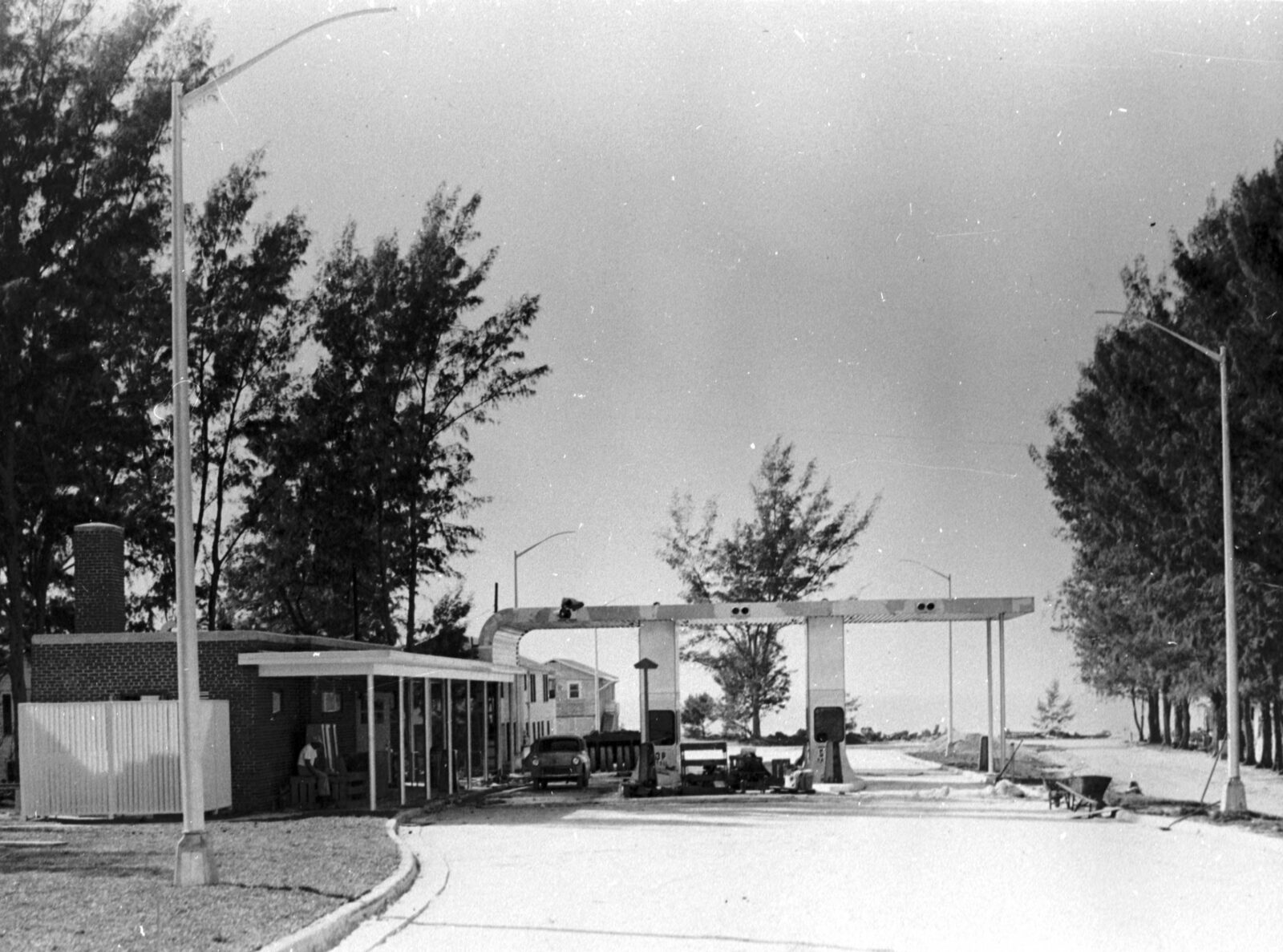Anna Maria’s Rich History

BY SARAH FISH
Long before Anna Maria Island became a vacation destination to travelers worldwide and currently home to around 1,800 permanent residents, the
sunny beaches that hug the Gulf waters were home to the first island inhabitants around 1000 A.D., the Timucans. Native tribes the Calousa and Tocobagans also used the 25,000-year-old barrier island for fishing,
hunting and foraging.
These tribes were responsible for the system of estuaries that sprawled throughout historic Manatee County and beyond. The tools for these mound builders were the shells that washed upon the shores, which now leave the island as souvenirs.
For thousands of years, native tribes reaped the benefits of fertile lands and a plentiful ocean. It wasn’t until the early 1530s that Hernando DeSoto and other explorers landed nearby and began the Spanish invasion that led to development of the area, wiping out the peaceful native population with disease and violence. The Spanish named the island Ana-Maria-Cay after Maria, mother of Christ, and her mother, Anna.
After centuries of territorial wars, the United States eventually claimed Florida as its own in 1819. It wasn’t until 1894 that the name Anna Maria Key was registered officially with federal records.
In that time, famous French Pirate Jean LaFitte, well known for helping Andrew Jackson defend New Orleans in the Battle of 1812, shipwrecked one of his vessels on the island in 1821 along the bayside south end of the island which is now named Leffis Key. LaFitte operated many ports along the Gulf of Mexico from Florida to Texas.
The Islander newspaper once reported that LaFitte was chased up the Manatee River by a U.S. warship in 1829. LaFitte’s ship ran aground, and witnesses saw his crew running away from the wreck carrying a treasure chest with them.
“They hid in the bushes and watched as the Navy craft set fire to their ship and then sailed away. The abandoned pirates supposedly dug a hole and buried the chest intending to return for it later, but they never did,” The Islander reported. It is even said that he also hid treasure somewhere along the shores of Anna Maria, which is still sought after to this day.








A NEW ERA
The first homesteader on the island was George Emmerson Bean in 1893, after whom Bean Point is named. At that time, his property covered the area from where North Point to Magnolia Avenue stretch now. While excavating his property, Bean found the bones of human remains and army-style brass buttons. It turns out the remain belonged to those of a federal fleet which in 1864 sunk near the island during the Civil War along with all those aboard it.
Bean and his sons were crucial to the modern development of the island. Along with John and Charles Roser, who invented the Fig Newton, the two families invested in their community and together created the Anna Maria Beach Company.
The company developed the original roadways throughout the island, allowing the first post office to open in 1902. It was operated out of the home of island resident Sam Cobb, whose successor, postmaster H.T. Watson, frequently mailed shell to his family and friends in England. He did this to prove the tiny post office was in fact bringing in enough receipts to remain in business. The first
municipal water system was also the company’s doing, and they platted land to build dozens of houses.
The Anna Maria Beach Company also built the original city pier in 1911 to accommodate visitors via steamships from Tampa and St. Pete. Barbara Lemieux Murphy, Vice President of the board of directors for the Anna Maria Historical Society, says her favorite part of Anna Maria’s history is envisioning those ships unboarding on the city pier.
“Ladies wore long dresses and carried parasols, and they would get off the ferry and come down Pine Avenue, which is beautifully paved now, but then it was just a dirt, dirt road and they would walk toward the gulf and end up at the beach house,” she says.
“The gentlemen always had their shotguns because there were palmetto bushes and there were snakes that would come out,” Murphy says, noting a nearly 12-foot-long rattlesnake skin from that era that is featured at the AMHS museum.
In 1913 the first church was built as a memorial to John Roser’s deceased wife. Over 100 years later, it still stands today on Pine Avenue. In that same year, a schoolhouse was built and to this day the island remains a small one-school district, although a new school has been built in a different location.
In 1922, the first bridge connecting the mainland to the island opened, just wide enough to accommodate the newly invented Model-T vehicles. The dangerous wooden bridge was operated by a hand crank that opened and closed the drawbridge to allow for boats and cars taking turns to pass. This newfound convenience added quickly to the development of Anna Maria Island
and Bridge Street soon became the center of commerce.
By 1926, a second bridge was built on the south end of the island connecting the mainland to Longboat Key. The residential population of the island boomed to a whopping 75 people by 1927, of whom were bootleggers and prostitutes among bookkeepers and owners of a gas station, a village store, the Pagoda Dancehall, a bath house and an inn. But just six years later the bridge was wiped out by a strong high tide.
The original jail was built in 1927 to contain rowdy drunks from the dancehall who were then subjected to mosquito torture within the jail’s walls.
“If people got out of control at the beer hall at the end of Pine Avenue, they’d be thrown in the slammer overnight,” Murphy says.
With just bars for windows and no screens on the jail structure, arrestees were at the mercy of the elements and ruthless bloodsucking insects. A fire destroyed the jail in 1940 and it was then that mosquito torture finally ended on the island.
The second bridge connecting the island to the mainland at Longboat Key was finally rebuilt in 1958, but not before a first attempt to reconstruct it in 1941
was thwarted by crooked contractors who ran off with $25,000 in funds raised for the project. The fundraising event featured circus performers from the area including a tightrope walker who stopped midway on a tightrope stretched over the bay to do a handstand in front of nearly 17,000 attendees.
By the 1940s and ‘50s, a thriving Anna Maria Island became home to over 800 permanent residents as well as a playground for baseball legends like Babe Ruth, who used the island during winter training through the early 70s. It was also a place for World War II military training exercises nearby where bomber planes would darken the skies and explosives would be detonated along Mullet and Passage Keys that, for a time, kept tourists away.
But once the war was over, developers quickly came in to snatch up cheap land. One island quickly became three incorporated cities, and more bridges were built to shuffle visitors and residents to and from the seven-mile stretch of land. Anna Maria incorporated in 1923; the City of Holmes Beach in 1950; the City of Bradenton Beach incorporated in 1953.
Evelynn Hoskins, now 80 years old, remembers how old Anna Maria used to be. She spent summers there as a child. “It was way different back in the day,” she says. “There just wasn’t much out here.” Hoskins is the current corresponding secretary for the Anna Maria Historical Society and can remember when there were only dirt roads where pavement is now.
“We took it for granted, like it was always going to be that way,” she added, noting that the invention of air conditioning is what really led to the boom in Florida’s population.
MODERN ANNA MARIA ISLAND
The permanent population of modern Anna Maria Island now continues to dwindle as developers buy up investment homes that turn into luxury vacation apartments. The Old Florida charm that the island is known for is only preserved by ordinances that ban high-rise buildings. These laws were written in Holmes Beach after the first and only two high-rise buildings on the island were razed back in the early 70s there, after the City of Bradenton Beach and Anna Maria already passed their own similar ordinances.
“At least we don’t have condos,” Hoskins says, adding that there’s no way to stop the development that threatens that Old Florida charm. “I don’t know how you can legislate keeping the old houses. We can encourage people. When I see something that’s always been there and all of a sudden, it’s gone, it’s painful.”
Today, much of the island’s rich history can be observed at the Anna Maria Historical Society Historical Park located on Pine Avenue. Built in 1920, the museum’s main building was originally the island’s icehouse. There you can stroll the grounds along the beautiful mangrove paths where the first freshwater well on the island was maintained. The park is adorned with lush native plant species reminiscent of when the island was first settled. You can also explore Belle Haven via guided tour, a home built in 1920 originally on the island’s city pier, and which fell into the waters in 1926. It was rescued from the depths and later relocated to where it stands now. The cottage is decorated with period-specific relics that show how early homesteaders once lived. The historical park also is home to the old city jail, now without a roof and decorated with cheeky sayings for touristy photo-ops.
The pristine beaches of the island continue to attract tourists from around the world and are nesting grounds for various sea turtles. The plentiful waters are a destination for fishing enthusiasts and a lifeline for commercial fishermen of the nearby historic Cortez Fishing Village. The century-plus-old city pier remains in place as a stop on the free trolley that takes visitors from one end of the island to the other.
“Most people really appreciate it,” Hoskins says of visitors to the museum. “They’re anxious to learn about the history of this area. When they look at the map, I can tell them I remember that’s how the area was,” she says. “That’s the reason I volunteer; so that I can tell people, Florida now is not as it’s always been.”
For more AMI history visit: Anna Maria Island Historical Society Free admission! Donations are welcome. 402 Pine Ave, Anna Maria, FL 34216
www.amihs.org
